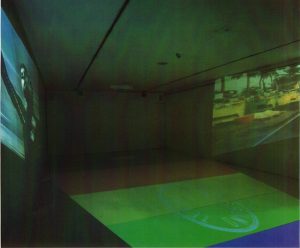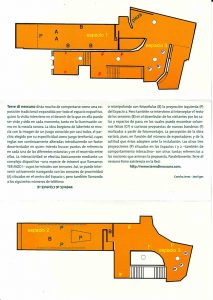

Fundación Telefónica. Madrid (2002)
Curator / Comisaria: Alicia Murría
Las TIERRAS DE NADIE son territorios libres de marca, de logo. Sin dueño, puesto que son tan salvajes como lo que una ausencia parcial o total de regulación les permite ser. Pero no son utopías puesto que tienen un topos definido y una existencia cierta.
Consideraremos por tanto TIERRA DE NADIE a todo espacio –real o virtual– en el cual se experimente inexistencia de reglas o cambio brusco de las mismas. En definitiva, es un espacio de/para la desorientación.
Las tierras de nadie son sistemas –o espacios– de ausencia, de negación: de no-regulación, no-presencia, no-estética, no-dueño. En cualquier caso, su oscura existencia parece asegurar, por contraste, la de un brillante mundo cada vez más conexionado, global, interrelacionado, escrutable, telepresente y comunicable. Pero no son tanto el otro lado del espejo de ese mundo cuanto la parte de caos que su empeño ordenador deja tras y en torno de sí. No se trata en este caso de un aparente caos, que pudiese formar parte de un grado de orden inasequible por incomprensible desde nuestro propio orden convencional y que, por eso mismo, interpretásemos en términos de caos. Las TIERRAS DE NADIE se comportarían como bolsas de caos generadas por el ejercicio y la expansión del orden inherente al sistema que las rodea. En este caso, la presión es la ejercida por el sistema social, económico, político y cultural en su expansión reguladora que precisa de espacios donde descargar –amontonar– todo el desorden que su imperfecta acción ordenadora genera, paradójicamente. Y sus restos más evidentes son todos los residuos –humanos y materiales– que nuestra opulenta sociedad produce.


NO-MAN’S LANDS lands are territories without a brand name or logotype. Without an owner, since they are as wild as the partial of total absence of regulation allows them to be. But they are not utopias, since they do have a well-defined topos and an undeniable existence.
Thus we shall regard as a NO-MAN’S LAND any space –real or virtual– in which there are no rules or the rules can suddenly change –in sum, a space of/for disorientation.
NO-MAN’S LANDS are systems –or spaces– of absence, of negation: of non-regulation, non-presence, non-aesthetics, non-ownership. At all events, their obscure existence seems to assure us, by contrast, of the existence of a brilliant world that is increasingly connected, global, interrelated, telepresent and communicable. But they are not so much the other side of the looking-glass of that world, as that portion of chaos that that world left behind it and around it in its efforts to order itself. In this instance it is not an apparent chaos, that could be a part of a degree of order that is inaccessible or incomprehensible from our own conventional order and which, for this very reason, we may interpret as chaos. NO-MAN’S LANDS would behave like pockets of chaos generated by the exercise and the expansion of the order inherent in the system that surrounds them. In this case, the pressure is exerted by the social, economic, political and cultural system in its regulatory expansion, and which needs spaces where it can unload –and pile up– all the disorder that its imperfect ordering paradoxically generates. And its most obvious remains are the residues –human and material– that our opulent society produces.
Catálogo de TERRE DI NESSUNO